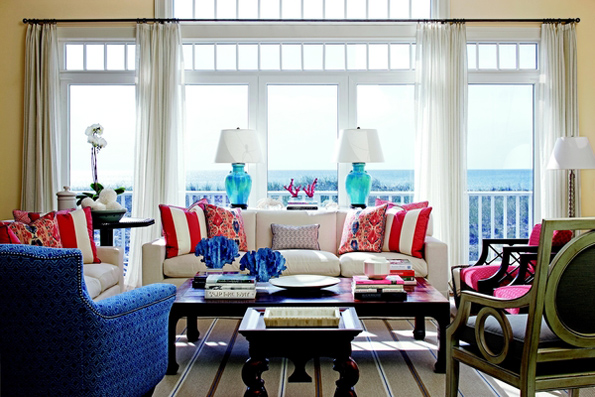
In designing the interior of a home, Alexa Hampton takes in the whole picture—by extending outside its four bare walls, and drawing on the surrounding natural landscape.
Ms. Hampton, a New York City designer who owns a second home in Southampton, has implemented her design technique throughout several homes on the East End—some of which have landed in colorful spots in her new book, “The Language of Interior Design.”
While Ms. Hampton declined to give contact information for the owners or disclose the general location of the homes that are featured in the glossy, hardcover book, at least four homes on the South Fork are included. That’s as specific as Ms. Hampton could get, due to contractual restrictions, she said.
The Hamptons hold a special significance for Ms. Hampton. As a child, she and her family would often visit the region on weekends, holidays and in summer. She said she revels in the fact that each Hampton community has its own unique personality—from the cliffs of Montauk to the “urban” Southampton Village, to an even “more urban” East Hampton Village, she said.
“It’s sort of amorphous,” she said. “People talk about the Hamptons as though it is all very similar, as though it’s one notion. But I think, you and I certainly know, the landscape changes.”
And it’s that shift in landscape that Ms. Hampton builds on to accentuate and guide her design work in East End homes. Ms. Hampton pointed to examples of just that in her book. She pulls from four themes to achieve a well-designed home: contrast, color, proportion and balance.
In one home, Ms. Hampton said she maximizes use of the natural “beautiful light that comes from the Hamptons” to dictate a beige, white and tannish color scheme. The pale colors, she said, are brought to life by the natural light that pours in through the windows. The house has generally got the feel of a beach home—even a painting of a beach scene sits atop the fireplace, which is dressed in white. The home is decorated in organic materials, like rattan and fibers that one would affiliate with a seaside home, she said. The feel of such a home, she stressed, differs from a New York City residence, in which it’s not uncommon to find hard materials, like metals or stone.
The result: a peaceful atmosphere and the feeling that you’ve escaped to somewhere serene— at least for those who travel from New York City to experience the Hamptons, she said.
“You want to be embraced from the thing that you’ve driven two hours to experience,” Ms. Hampton said. “You want the escape from the city. You want the quietness you experience from the Hamptons … you want to exult all of the qualities that cause a person to enjoy the Hamptons already.”
Ms. Hampton said the Hamptons, and the diversity of the East End, hold a special significance for her and her family. As the daughter of the famous interior designer Mark Hampton, she said the core principles of design run through her blood. Ms. Hampton became a part of the design world at age 13, when she began working at her father’s firm, Mark Hampton, LLC. In 1998, she became the company’s president.
Perhaps what differentiates Ms. Hampton from other contemporary designers is a prevalent theme of tradition in her finished products.
“For the past 10 years, looking at design magazines, I have noticed as a discipline, design has become more free-form,” she said. “And I think I’ve discovered in my own personality I was a little more formal than that.”
At least one antiques store owner on the East End, whose business Ms. Hampton often frequents for her clients out east, can vouch for that.
“I think Alexa Hampton follows in the famous tradition of her father with a fresh take on interior design and classic furniture,” said Chris Mead, the owner of 20-year-old English Country Antiques, an antiques and home furnishing company with locations in Bridgehampton and Southampton.
Mr. Mead said Ms. Hampton’s style in design is essentially in line with the kind of products he sells—the most popular items being various kinds of antique tables and chairs. In his personal opinion, with typically large homes on the East End, it’s probably most prudent to buy a significant piece of furniture. “I think in the Hamptons there are a lot of second homes,” he said. “They seem to be in the large scale. So they actually look better with a little bit more important furniture in rather than minimalist.”
Michael Hofstadter, the manager of both branches of Mecox Gardens, another furnishing business with locations in East Hampton and Southampton, said they are a big fan of Ms. Hampton’s firm. Ms. Hampton often shops there.
The store sells Ms. Hampton’s new book, Mr. Hofstadter said, noting that he’s probably even identified a piece or two from his store that was featured in one of the homes in the book, including a prominent, dark-colored tray.
Mr. Hofstadter classified Ms. Hampton’s work as timeless—something that won’t go out of style in 10 to 15 years. And that’s a designing principle he said his business strives to emulate.
“We think a really good investment is to purchase an item that will hold up to the test of time,” he said.